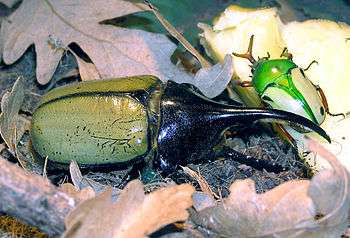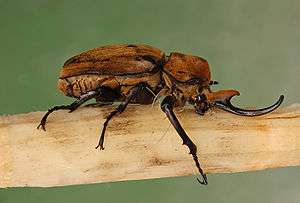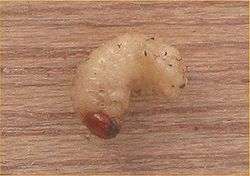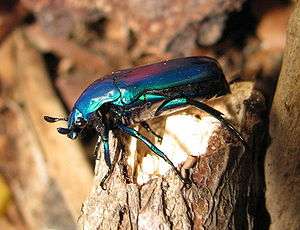Wikijunior:Bugs/Beetle
< Wikijunior:BugsWhat does it look like?

Beetles belong to the order Coleoptera. There are about 350,000 named species. They are an amazingly large and varied group of insects. Beetles living in the tropics can be more than 5 inches long. Smaller species are smaller than a grain of rice. Some have bright colors or are iridescent, shimmering with a rainbow of bright colors. Some have bold dots, stripes, and unusual patterns. The vast majority, however, are dull shades of brown and black. They can be rounded or long and thin.
Most beetles have similar types of bodies. Their bodies are covered by a hard, jointed, external covering called an exoskeleton. Numerous plates provide armored defense and flexibility. The body is divided into three sections: the head, the thorax, and the abdomen.
They have wings and most can fly. Beetles belong to the order Coleoptera which means “sheath wings.” The name refers the plates or "elytra" that cover and protect the wings. When the beetle is resting, the elytra usually meet in the middle of the back.
They have large prominent compound eyes. Beetle antennae may be threadlike or clubbed. Beetles have chewing mouthparts with well-developed jaws called mandibles. The Stag Beetle, has mandibles that look like the antlers of a deer.
Where does it live?
Beetles can be found all over the earth in all kinds of habitats. Some, like the Lady Bug or Lady Bird Beetle, live on plants. Others live in dark, moist places under logs, rocks, and leaves. They live in gardens, grain fields, ponds and lakes. They have not been found in the frozen areas around the North and South Poles.

What does it eat?
Beetles have mouth parts designed for chewing solid foods, so their diet is broader than other insects. Some are omnivores, eating both plants and animals. Others have highly specialized diets feeding only on a single kind of plant. Some eat and digest wood, resin, or sap. A few drink only the liquids of plants, trees, and fruits. Carnivorous beetles eat small prey such as earthworms and snails. Carrion Beetles eat dead animals. Clown Beetles eat the larvae of other insects. Diving Beatles eat tadpoles and other small water creatures.
How does it defend itself?
The beetle’s soft body and membranous wings are protected by the elytra, the front pair of wings. The elytra are thickened into hard covers which fold back to make an effective shield.
Beetles have various defense strategies, including camouflage, mimicry, and poison. They use camouflage to blend into their surroundings to hide from predators. They mimic the color or shape of other insects to deceive enemies. Many Longhorn Beetles look like wasps, even though they are harmless. Ladybird Beetles fall to the ground and "play dead" They also secrete a bad tasting fluid from the joints in their legs.
What stages of metamorphosis does it go through?

Beetles undergo complete metamorphosis with an immature larval stage and a pupal stage. Larvae (grubs) are often worm-like and lack compound eyes. They usually have biting mouthparts. They can be predacious or vegetarian. Wings develop internally during the juvenile stages.
The last resting stage before the final molt is called a pupa. Pupae do not feed and are usually relatively inactive. They are vulnerable to predators and parasites. The pupal case is shed when the adult beetle is ready to emerge.
Beetles mate in spring or summer. Most species produce one generation a year. Some may produce as many as four.
What special behavior does it exhibit?
Scarab Beetles push or roll balls of dung to their brood sites. It is thought that this behavior inspired the design in Egyptian art showing the Scarab Beetle pushing the sun along its course in the sky.
Although most beetles have a hard time righting themselves when turned upside down, the Click Beetle does not. It has a special mechanism on the underside of its body to help it spring into the air to right itself. It is named for the clicking sound it makes when doing this.
Many beetles make noises by tapping on hard surfaces or by rubbing parts of the body together. These beetles seem to have better hearing than beetles that do not make such sounds.
Burying Beetles are known to hide small animal carcasses from mammalian scavengers. A small dead animal, such as a mouse, supplies food for a whole brood of larvae that a pair of beetles will care for together.

How does it affect people?
People in some parts of the world sell Horned Beetles that have been bred for fighting.
Beetles are among the most important of the insect recyclers. Many species are decomposers that feed on dung or dead plants and animals. Some beetles are helpful to people. Ladybird Beetles eat aphids and other insects that harm crops. Ground Beetles feed on Potato Beetles that ruin potato crops.
Some beetles are pests that can transmit disease. Others cause millions of dollars in damage to plant products. Woodworm Beetles damage furniture and wood floors.
References
http://insected.arizona.edu/ladyinfo.htm
Milne, L. & Milne, M. (2003). National Audubon Society field guide to North American insects and spiders. NY: Alfred A. Knopf.
Newton, B. (2005). Stag beetles.
Raven, P. H. & Johnson, G. B. (1999). Biology, (5th Ed.). Boston, MA: WCB/McGraw-Hill.
Thomas, J. (2001). Beetles. In Nature’s children. (Set 7). Danbury, CT: Grolier Educational.
Zim, H. S. (1987). Insects, A guide to familiar American insects. NY: Golden Press, NY.